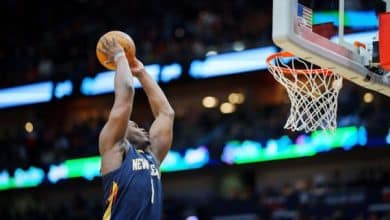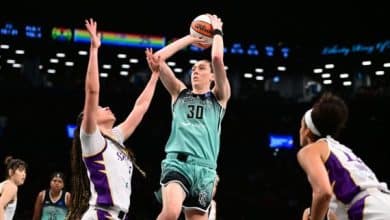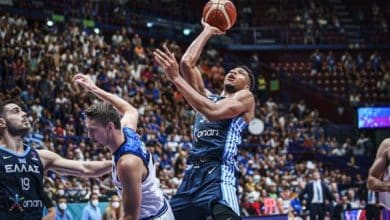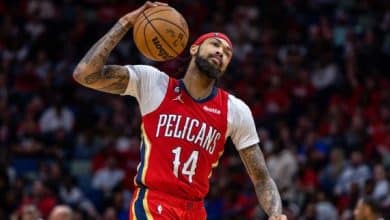This June 30, at 6:00 p.m. in the United States, and therefore midnight in France, the “free agency” opens its doors, and like every year, we are going to experience two or three completely crazy days, with signings in all directions, and undoubtedly exchanges. This even started a few days ago since the “transfer window” is now carried out in two stages. “Free agents” can discuss with their own franchises since the end of the Finals. Which allowed Pascal Siakam and Malik Monk to already extend.
Like every year, many stars find themselves without a contract, and this year, there is for example Klay Thompson, Paul George, LeBron James and even James Harden. Like every year finally, exchanges will liven up the offseason, and all eyes are on Klay Thompson and Paul George.
To help you navigate the terms and salaries, DNA of Sports provides you with its little guide to the NBA transfer window, but also a page with all the movements of the 2024 offseason.
THE BEST FREE AGENTS
Leaders – Backs – Wingers – Power forwards – Pivots
DO YOU SPEAK FREE AGENCY?
– Free agency : period between June 30, 2024 and February 2025. It allows NBA franchises to recruit players free of any contract, but also to carry out exchanges. From Sunday evening, we can expect a multitude of signings of players at the end of their contracts, and generally, the biggest free agents are signed very quickly, often from the first minutes of the opening of the transfer market.
– Salary cap : This is the salary mass defined by the NBA. For the upcoming season, it will be $179 million, but NBA franchises have the possibility of exceeding it when they extend their own players or via “exceptions”.
– Luxury tax : In the NBA, the salary cap is not strict, and the NBA allows the richest franchises to exceed the threshold set with a tolerance margin of about 20%. In this case, this year, franchises can spend up to $190 million. Then, for each dollar spent above this ceiling, franchises must pay the “luxury tax” to the NBA. Starting this year, this tax is much more punitive, and if teams exceed the “luxury tax” too much, the NBA has implemented thresholds with sanctions such as the inability to make “sign-and-trades”, to place on players who have negotiated a “buy-out” or to transfer draft picks.
– Cap hold : this is the “trace” that a player occupies in the payroll. Even if a player is no longer under contract with a team on July 31, he can be counted virtually on the payroll when the market opens. This trace was designed to prevent a franchise from releasing all its players in order to sign the free agents of other teams before then re-signing its own thanks to their “Bird Rights”, even if it means going over the limit.
– Larry Bird Exception : rule which allows any franchise to exceed the salary cap when it extends one of its players. The Raptors or the Mavericks can therefore explode their payroll by extending Fred VanVleet or Kyrie Irving.
– Mid-level exception : $12.9 million envelope available to recruit all NBA franchises that do not pay luxury tax. They can use it on one or more players. A team that must pay the luxury tax only has $5.2 million.
– Minimum Salary Exception : Each year, each franchise has the opportunity to sign as many players as it wants for the minimum salary. The more senior a player is, the higher the salary he will receive. Some veterans, lacking a title, choose this option.
– Moratorium : moratorium set by the NBA between the start of free agency and the official date of signings. Since 2016, and following DeAndre Jordan's about-face with Dallas, the NBA and the players' union have reduced this duration to 6 days, and not 11 as before. Each signing announced on Sunday will not be official until a week from now, i.e. next Saturday.
– Offer sheet : a free agent protected by his franchise has the possibility of accepting an external proposal. This is what is called an “offer sheet”. His franchise then has 48 hours to align itself, and thus keep him. This season, a player like Obi Toppin will be able to sign an “offer sheet”, and Indiana will be able to align itself with it if the team wishes to keep him.
– Opt-in : it is the fact of activating a clause to extend a contract. Like for example Russell Westbrook or D'Angelo Russell who chose not to test the market.
– Opt-out : it is the act of activating a clause to free oneself from a contract. This is what Paul George and LeBron James did.
– Qualifying offer : proposal made by a franchise to one of its players during the last year of his rookie contract. Based on his previous salary, this offer makes him a “protected free agent” and aligns with any offer made to the player by another franchise. If the player then signs this qualifying offer, he is automatically free next season, and his team will no longer be able to match an offer to keep him.
– Restricted : in French, we translate it as “protected” at DNA of Sports. An adjective used to mean that a free agent still depends on his team since it can match any offer (see “offer sheet”) that will be made to him. This season, Isaac Okoro or Obi Toppin are “restricted” free agents (RFA).
– Team Option : this is the equivalent of the “opt-in” and “opt-out” clauses but for teams. Thanks to this type of clause, a franchise can part ways with a player and make him a free agent. Conversely, they can also activate this clause to prevent a player from being a free agent. This year, the Pistons used their “team option” to separate themselves from Evan Fournier.
– Unrestricted : it is the opposite of “restricted”, and is translated as “unprotected”. This means that the player is free to sign wherever he wants, without his franchise being able to match an external offer. This is the case this year for Klay Thompson or Paul George for example.
– Sign-and-trade : an operation that consists of signing one of its free agents and then transferring him. Some franchises use this system to avoid seeing one of their players leave without any compensation. This may be the case for Klay Thompson if he wants to leave the Warriors.
– Trade : it's a classic trade. Like the one between the Hawks and the Pelicans, around Dejounte Murray.
WHAT ARE THE MAXIMUM SALARIES?
Contract extension (up to five years of contract, with an increase of 8% per year)
– Less than seven years of experience: $35.2 million the first year (max: $204.4 million over five years)
– 7 to 9 years of experience: $42.3 million the first year (max: $245.3 million over five years)
– Ten years and more: $49.3 million the first year (max: $286.2 million over five years)
Signing with a new team (up to four years of contract, with a 5% increase per year)
– Less than seven years of experience: $35.2 million the first year (max: $151.6 million over four years)
– 7 to 9 years of experience: $42.3 million the first year (max: $181.8 million over four years)
– Ten years and over: $49.3 million in the first year (max: $212.2 million over four years)













